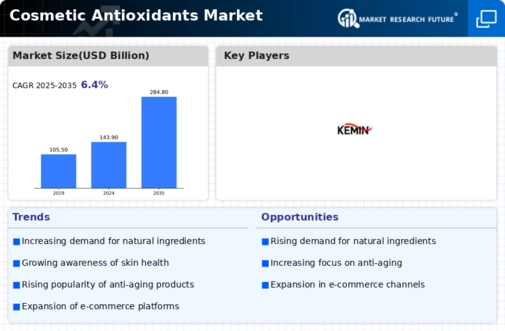Top Industry Leaders in the Cosmetic Antioxidants Market
 The global cosmetic antioxidants market is a dynamic and growing space, fueled by consumers' increasing awareness of the benefits of these ingredients for healthy, youthful-looking skin and hair. As the demand surges, competition among players intensifies, leading to diverse strategies and a constantly evolving landscape. Let's delve into the key aspects of this market, from strategies and market share factors to industry news and recent developments.
The global cosmetic antioxidants market is a dynamic and growing space, fueled by consumers' increasing awareness of the benefits of these ingredients for healthy, youthful-looking skin and hair. As the demand surges, competition among players intensifies, leading to diverse strategies and a constantly evolving landscape. Let's delve into the key aspects of this market, from strategies and market share factors to industry news and recent developments.
Competitive Strategies:
-
Innovation and Differentiation: Leading players are developing novel delivery systems for antioxidants, enhancing their stability and efficacy. Encapsulation technologies and advanced formulations are key areas of focus. For example, Ashland launched a new line of lipophilic vitamin C derivatives that offer improved skin penetration and efficacy. -
Natural and Sustainable Sourcing: The rise of eco-conscious consumers is driving demand for naturally-derived antioxidants. Companies are collaborating with botanical extract suppliers and investing in sustainable farming practices. BASF recently partnered with Croda to develop sustainably sourced astaxanthin from microalgae. -
Scientific Validation and Transparency: Claims backed by robust clinical data are crucial for building trust and brand differentiation. Companies are investing in research and clinical trials to substantiate the anti-aging, anti-inflammatory, and photoprotective properties of their antioxidant ingredients. Unilever's research on green tea's ability to protect against pollution damage is a prime example. -
Targeted Marketing and Consumer Education: Reaching out to specific consumer segments through targeted campaigns and online platforms is essential. Educational content highlighting the benefits of antioxidants and addressing consumer concerns about synthetic ingredients is a key strategy. L'Oréal's "Science of Beauty" platform provides in-depth information on their antioxidant ingredients and their benefits. -
Strategic Partnerships and Acquisitions: Collaborations with research institutions, ingredient suppliers, and even competitors can accelerate innovation and market access. Acquisitions of smaller companies with unique technologies or ingredient sources are also seen. Givaudan's acquisition of Novacor underscored its commitment to expanding its portfolio of natural antioxidants.
Factors Influencing Market Share:
-
Product Portfolio and Brand Reputation: Companies with a wider range of innovative and scientifically-backed antioxidant products, coupled with a strong brand image, tend to hold a larger market share. -
Distribution Channels and Pricing Strategies: Effective distribution channels across online and offline platforms, along with competitive pricing strategies, are crucial for reaching consumers and driving sales. -
Sustainability and Ethical Sourcing: Consumers are increasingly looking for products made with ethically sourced and sustainable ingredients. Companies adhering to these principles enjoy an edge over competitors. -
Regional Preferences and Cultural Nuances: Understanding regional preferences for specific antioxidants and addressing cultural nuances in marketing are essential for success in diverse markets.
Key Companies in the Cosmetic Antioxidants market include
- BASF SE
- Koninklijke DSM NV.
- Wacker Chemie AG
- Eastman Chemical Company
- Lonza Group
- Croda International Plc
- Ashland Holdings
- Evonik Industries AG
- Kemin Industries, Inc.
- Barentz International BV
Recent Developments:
September 2023: BASF and LanzaTech collaborate to produce sustainable squalane, a key antioxidant ingredient, from waste gases.
October 2023: The European Commission proposes stricter regulations on cosmetic antioxidants, raising concerns among some industry players.
November 2023: Unilever joins the Clean Beauty Collective, further emphasizing its commitment to sustainable sourcing of botanical ingredients.
December 2023: L'Oréal announces the successful completion of a clinical trial demonstrating the anti-aging efficacy of its resveratrol-based formula.









